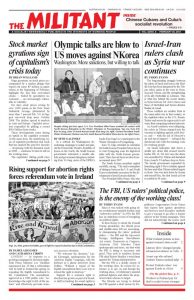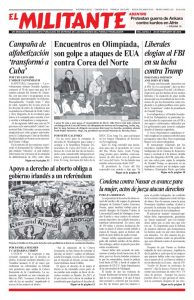The long-standing struggle between the rulers of Israel and Iran in the Middle East has been sharpened by the Tehran rulers’ gains in the wars in Syria, Iraq and Yemen, and the strengthening of its ally Hezbollah in Lebanon. This is what lies behind the recent clashes in Syria between Tel Aviv’s forces and those of Hezbollah and Syrian dictator Bashar al-Assad.
These conflicts are another front in the many-sided war in that country, as the capitalist rulers in the U.S., Russia, Turkey and across the region seek to advance their competing national interests.
As Assad’s military was collapsing, the rulers in Tehran stepped into the vacuum in fighting against rebel forces, and — with the aid of Moscow’s air and naval support — salvaged his dictatorial rule with devastating costs for working people.
An Israeli helicopter shot down a stealth spy drone that crossed Israel’s border Feb. 10. Tel Aviv says the drone was assembled by Tehran and launched from Assad’s T4 airbase deep in Syria. The Israeli government responded by launching eight F-16s to retaliate against the base and other Tehran-related targets in Syria. One was shot down by Syrian anti-aircraft fire, the first Israeli jet lost in combat in 36 years.
Iran’s counterrevolutionary cleric-led regime has expanded its influence in Syria, establishing a route Tehran can use to send materiel to its forces there and to its Hezbollah ally in Lebanon.
Tehran has also signed deals with the Assad government for mining rights and to set up air and sea bases in Syria. The Iranian rulers confront working-class unrest as a consequence of body bags coming home carrying working-class youth killed in Syria, Iraq and elsewhere. But they have no intention of halting their intervention, having made substantial gains in the fighting.
The Israeli rulers say they will not accept a permanent presence of Iran’s Revolutionary Guard forces and Hezbollah and other Shiite militias groups organized and armed near Israel’s border. Israeli Prime Minister Benjamin Netanyahu told Russian President Vladimir Putin in January that Tel Aviv will “act accordingly” to drive Tehran back and prevent Iran’s rulers from aiding Hezbollah in producing advanced weaponry in Syria or neighboring Lebanon. Israeli forces have consistently launched airstrikes against convoys it says Tehran is running through Syria to Lebanon.
With Washington’s backing, the Israeli rulers waged a murderous war against Lebanon in 2006, with the goal of decimating Hezbollah. They attacked shortly after Assad ended the Syrian rulers’ 29-year occupation of Lebanon. At its peak, Damascus had 30,000 troops stationed there. They fought against both Israeli troops and various Lebanese political factions.
As Iran’s counterrevolutionary regime consolidated its rule in the early 1980s, it began efforts to establish allies in the region. One of their first moves was to set Hezbollah up in Lebanon and aid the outfit in targeting Israeli troops that had invaded that country.
Last month Israeli officials announced plans to build a new class of medium-range missiles that can target Hezbollah. Tel Aviv is also building a wall along Israel’s Lebanon border.
The Israeli government has made it clear they will take whatever steps they deem necessary to keep Hezbollah and Revolutionary Guard troops away from its border. “There are no limitations,” Israeli Defense Minister Avigdor Lieberman told the Jerusalem Post Feb. 13. “This is not the time to bark, this is the time to bite.”
Alongside Tel Aviv, the U.S. capitalist rulers are also determined to counter Tehran’s rising influence in Syria. On Feb. 7 U.S. forces launched air and artillery strikes at Syrian government forces and a Tehran-backed Afghan militia that were attempting to retake oilfields held by the U.S.-backed Syrian Democratic Forces in Deir el-Zour province. Washington, with 2,000 troops and its air power, and the Kurdish-led SDF control over a quarter of Syria, including most of its oil fields, which were taken in beating back Islamic State. The airstrikes stopped the attack, killing 100 of the pro-Assad fighters..
At the same time, Assad’s forces, backed by Moscow’s air power, are carrying out brutal bombing assaults on opposition-held areas in the eastern Ghouta suburb of Damascus and the northwestern province of Idlib. They and their Tehran-backed allies have besieged eastern Ghouta for five years. With food and medicine almost out, many among the 400,000 people living there face starvation.

